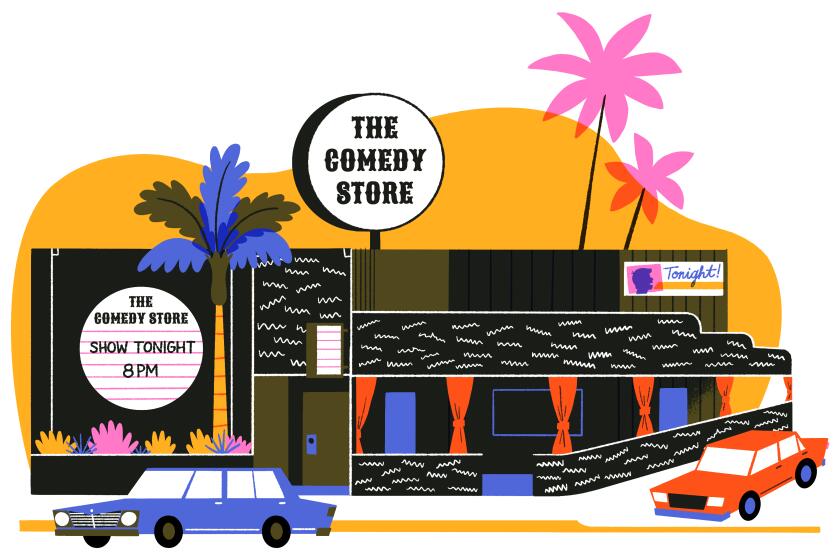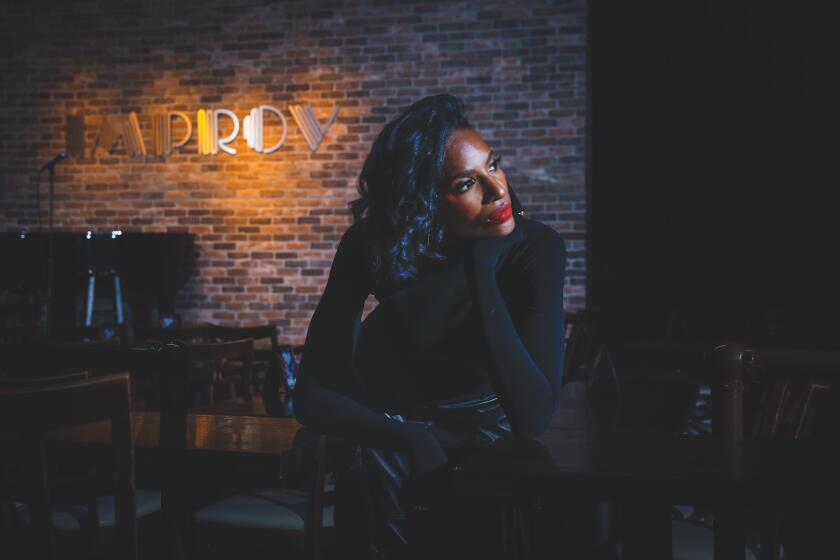How comedy photographers capture the energy of L.A.’s post-pandemic stand-up scene
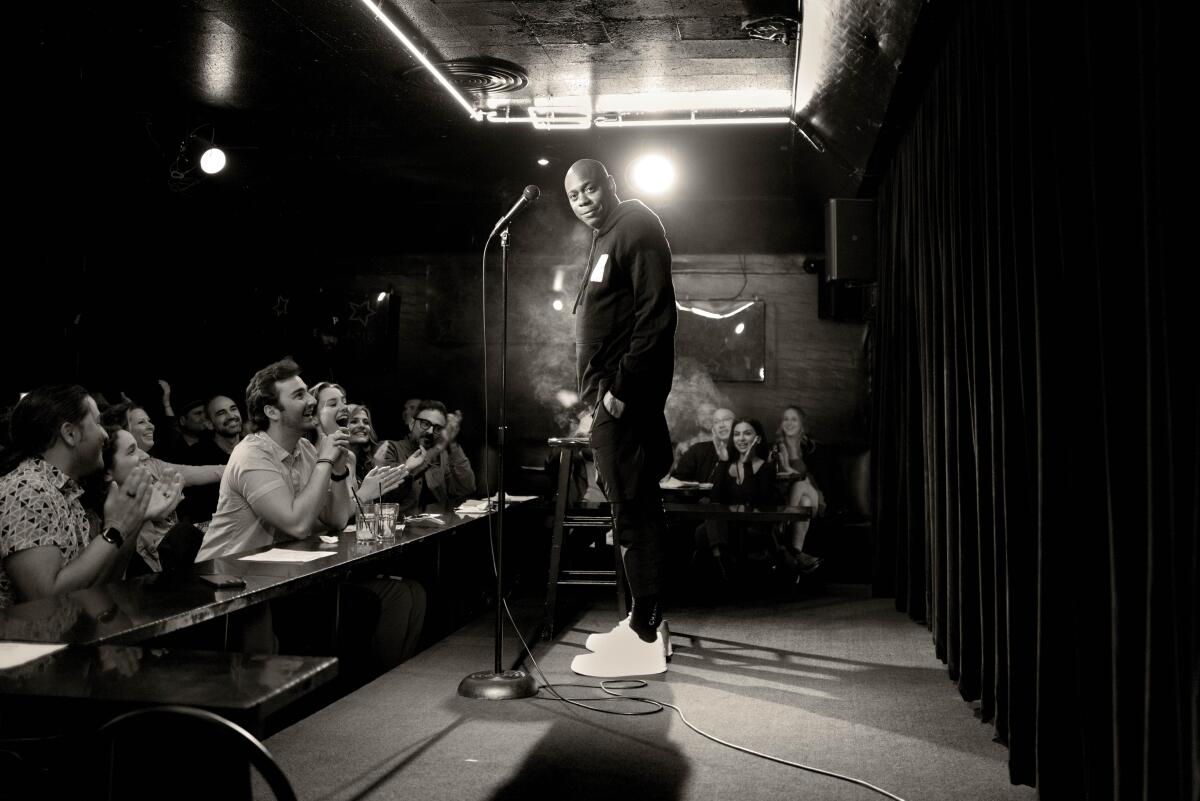
- Share via
What’s the best way to photograph a joke? How can a still image convey stage presence or audience connection? Whether it’s capturing special moments backstage at a comedy show or the biggest headlining experience in the life of a stand-up comic, the photographers working behind the scenes at Los Angeles clubs are time-stamping the scene, one still image at a time. Though they may not be as well-known as the talent they snap, they are vital in documenting the L.A. scene’s post-pandemic rebirth, the ever-changing venue landscape and our current live boom as a whole.
Comedy photographers can provide talent headshots, images for fliers and social media posts. Clubs are hard-pressed to advertise lineups without the protographers shooting in the trenches. They provide a sense of being there, laughing in the moment amid a sea of strangers. In certain cases, they capture art from the act of art being made. Video content might be king for clicks, but it’s the local photogs peering from shadowy corners through lenses and screens, hearing it all again but still laughing at the best parts every time, that truly foster the connection between commerce and comedy artistry. Recently, we spoke with a handful of L.A.’s busiest comedy scene photographers about what makes their job so unique.

What are the challenges in conveying humor using only still image?
Jill Petracek (Dynasty Typewriter, the Elysian, UCB, Largo): My instinct is to get a person’s character into a photo, whether it be goofy, gritty, messy, chic... I’ve found if I focus too hard on making a photo “funny,” I end up either irritating the comic with bad suggestions or just taking a photo they’ll never use. My best work is documentary-esque, taking photos of people who are enjoying each other’s company. When people make themselves or other people laugh, that’s the best.
Michael Schwartz (Ice House): I have a BPS [a bachelor of professional studies] degree in commercial photography with a minor in portraiture from — at the time — the finest photography college in the world, Brooks Institute of Photography in Santa Barbara. My training was very formal and commercial. I expect quality in my work, so that is almost as important to me as conveying the humor. The lighting, color, contrast and sharpness all matter to me. In my mind, any subject wants to look good in their photos, and that is my mission. That is where a good quality shot matters.
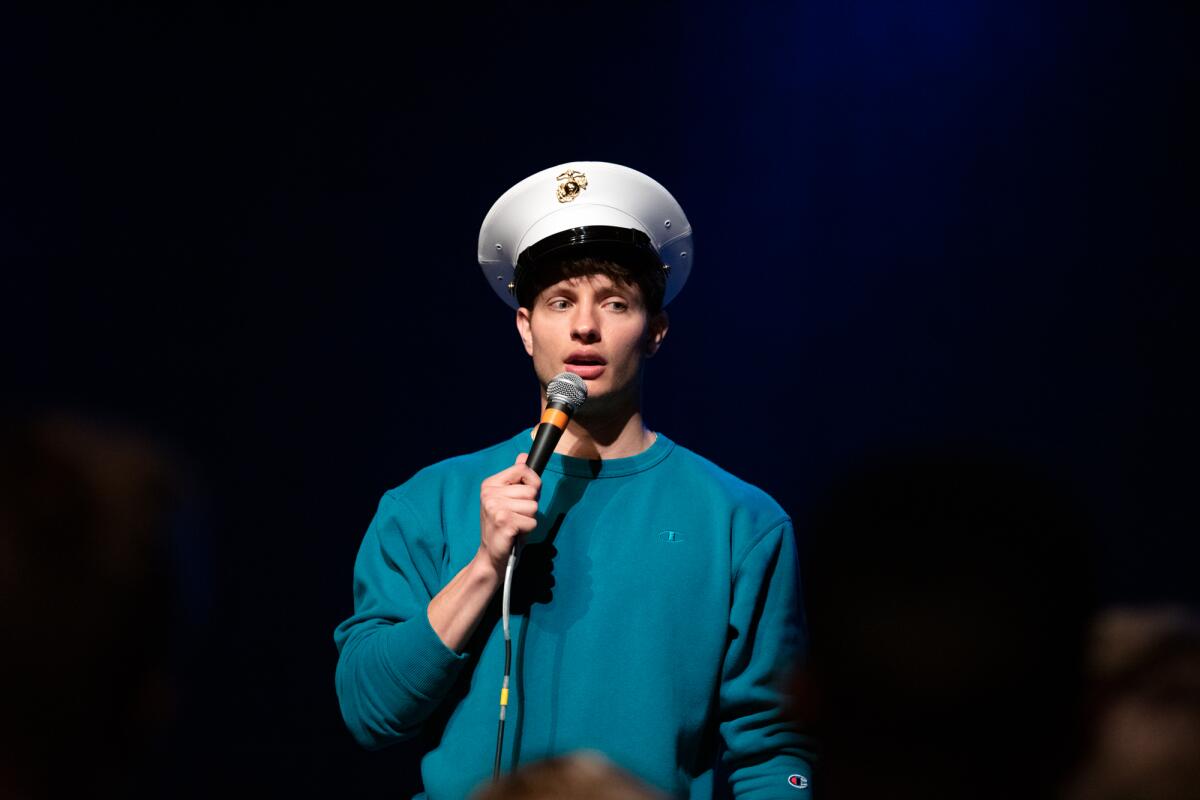
Anthony Acero (HaHa, Laugh Factory, the Kookaburra Lounge at the Ovation Hollywood): Technical challenges include lighting, venue seating arrangements and having more than one photographer shooting the same show. A lot of venues like to use the color red and low lighting, which can make it very difficult to capture a good image. Often, I’ll get that one shot, and it will be negatively impacted by a red overhead light shining on the performer’s face.
Monique Hernandez (“There’s so many”): It’s hard to convey a joke or a sketch with one picture without making it seem zany or cringey. So you have to capture their personality through their expressions and their mannerisms.
Greg Feiner: (Comedy Store, Improv, the Elysian, Lyric Hyperion, UCB… “a lot of shows in spaces that are aren’t expressly for comedy”): You want to see in a comedian’s eyes that they’re comfortable, at ease. If that comes through, then they can be doing something that looks totally goofy but they’ll still look cool doing it because you can still tell they’re in control up there.
Matt Misisco (Comedy Store, Improv, Dynasty Typewriter): Understanding a comedian’s timing. Every comedian has their own style, so knowing when the punchline or act-out is coming can be hard to predict. Usually, I have to photograph the comedian once or twice before I can get the perfect shot.
Liezl Estipona (Largo): I do my best to capture moments while also trying to be neutral and respectful about my coverage, knowing comedians might be working out their material. I appreciate the trust UCB, Largo and the performers gave me to be in their presence behind the scenes and onstage, and I try not to betray that.
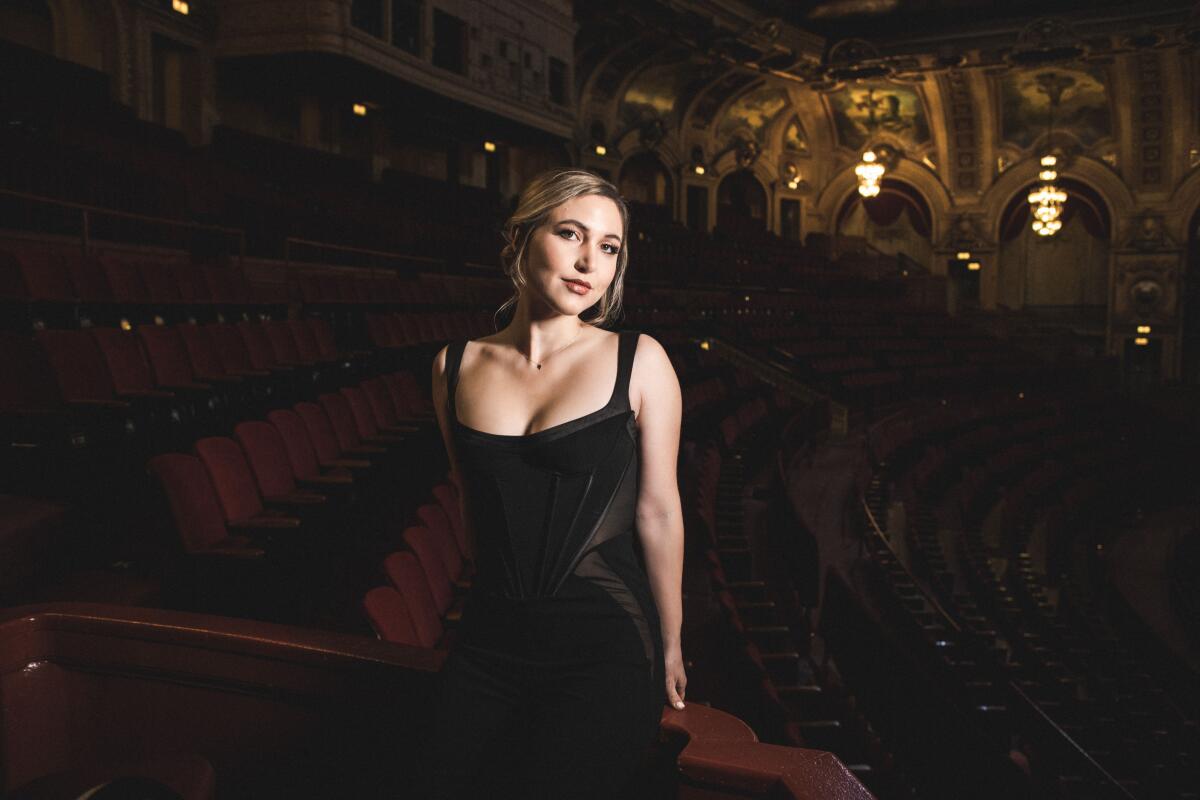
Evan Perkins (UCB): Since the show isn’t planned out in advance, the cast is moving throughout the stage in unpredictable ways for the entirety of the show. That provides a unique challenge for me as a photographer, as I need to adapt and move throughout the venue to follow the action. In doing so, there are moments when I’m unable to capture the moment exactly how I’d like, and it’s a wonderful lesson in letting go and experiencing what is unfolding in front of me, regardless of whether or not it results in a picture I had wanted.
Van Corona (Comedy Store, the Elysian “and occasionally pop-up comedy shows at bars”): I had a long, philosophical answer, but the real answer is “low light and limited angles to shoot from.”
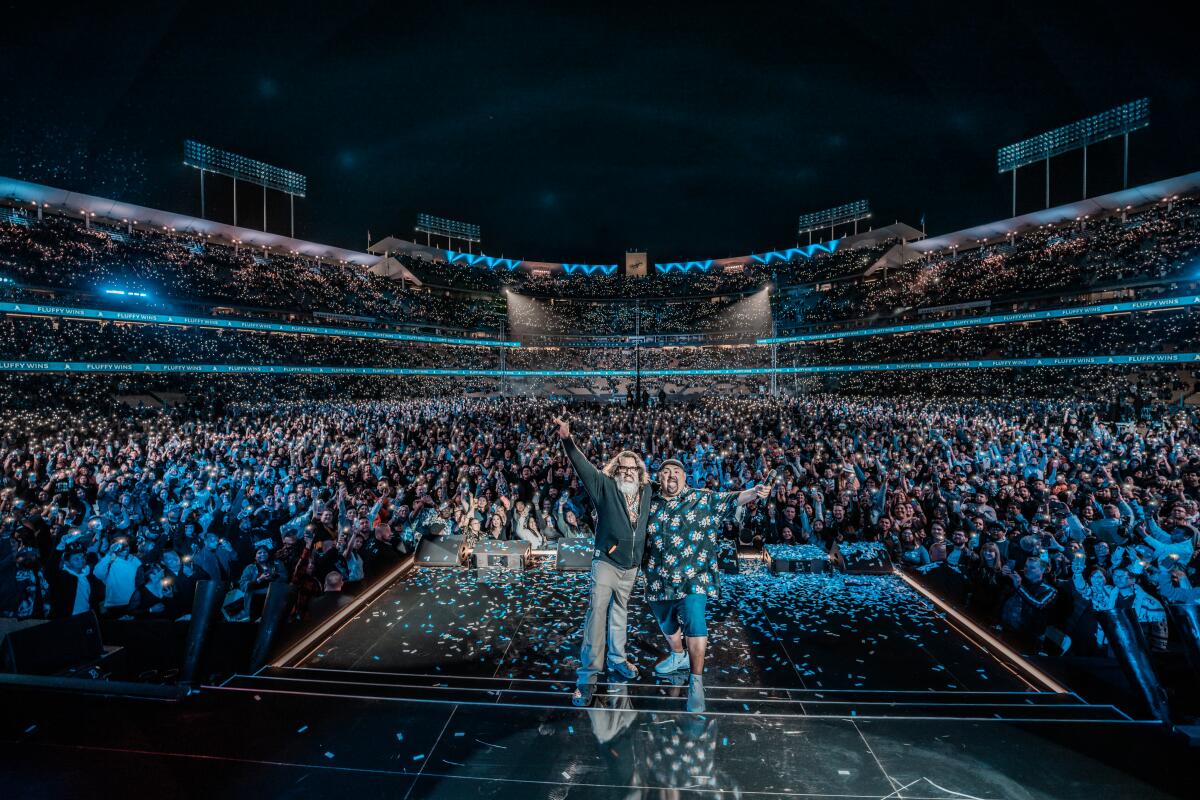
What are the most memorable performances you’ve photographed?
Estipona: One of my favorite things to photograph over the years was Never Not Funny’s Pardcast-a-Thon, which is a 12-hour marathon to raise money for Smile Train, in which Jimmy Pardo would bring out a secret slate of guests every 20 minutes. I started out in the audience but eventually ended up backstage taking guest portraits. Because the team behind it is so small, it always felt like a family reunion to see the [Never Not Funny] crew and regular guests every year. As for current day, sometimes I photograph Judd Apatow’s fundraiser shows at Largo, and he tends to have some crazy guests that have included everyone from Bo Burnham and Eric Idle to Beck, but there was one specific show where Jim Carrey dropped in.
Schwartz: One of the coolest things was to be flown to the Bahamas by Tom Segura to photograph his marriage to Christina Pazsitzki in 2008. In 2003, I photographed the Smothers Brothers over two nights at the Comedy Store, which brought out the stars. I recently photographed the Unknown Comic, Murray Langston, at the Ice House, which was just a classic show and memorable event.

Misisco: Some of the most memorable performances that I have photographed were during “Goddamn Comedy Jam,” a comedy-rock show [that] has been around for 10 years or so. Honestly, there are too many great shows to recount, but a few of the top performances were by Tiffany Haddish, Jim Jefferies, Bill Burr and Adam Ray.
Kim Newmoney (The Virgil, the Improv): In 2016, I was supposed to take portraits the night after the election. Ilana Glazer and Sabrina Jalees were headliners. Decidedly, no one was in the mood to have their picture taken, and I ended up just attending the show. Every comedian that took the stage did their set tearfully. There was so much collective pain and anguish on that stage and throughout the venue. I hugged my best friend and sobbed in her arms as comedians poured their hearts out and pontificated on how a Trump presidency would jeopardize the women, femme and nonbinary people of our country.
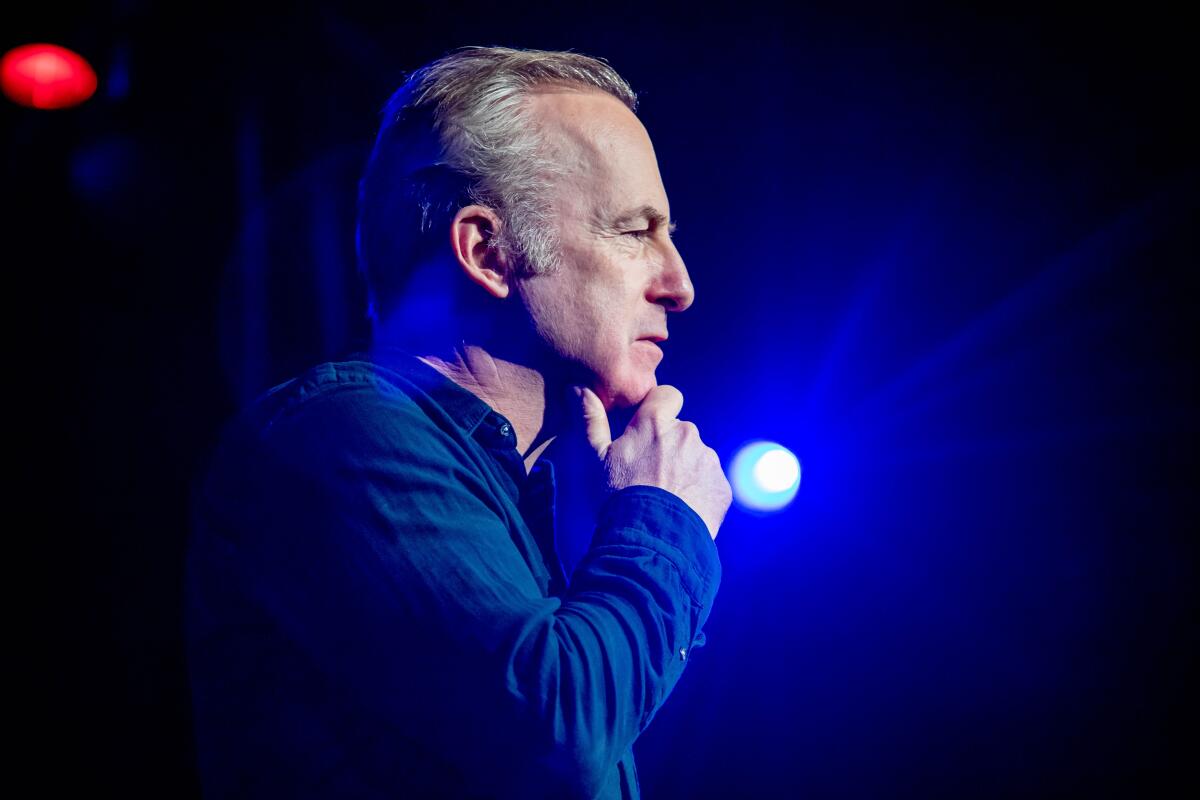
Feiner: I love whenever I have the chance to shoot clown shows because they’re so fearless and shocking that it’s hard for the photographs to turn out bad. I really loved one character I saw Christina Catherine Martinez do in early 2020, pre-COVID, where she was a girl who had just gotten broken up with, but she had shrimps for eyes. Anything bugnuts like that is my absolute favorite to shoot.
Andrew Max Levy (Dynasty Typewriter, the Elysian, Largo): “Low Key Outside,” Matt Rife and Paul Elia’s show that started in September 2020. I hadn’t shot comedy since [COVID closures] started, and they ran an incredible show that brought me back into the light after the photography-less summer. I also loved shooting Taylor Tomlinson’s special “Look at You” at the Wilbur in Boston; in addition to photographing the special, BTS [behind the scenes] of the portrait shoot was featured in the B-roll over the credits, a rare front-of-camera appearance for me.
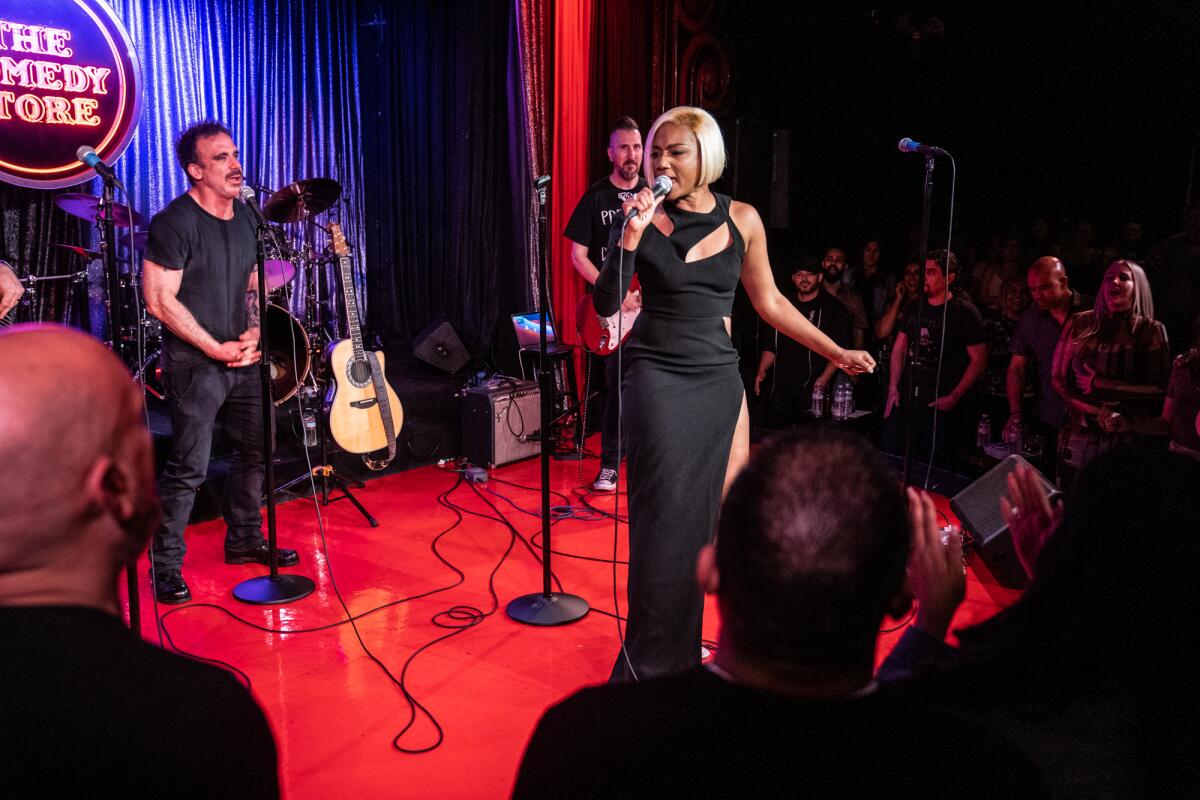
Hernandez: I’m a huge Nicole Byer fan and would always see her at the Largo before I started shooting comedy, so when I got the opportunity to shoot her at “The Last Improv Show,” it was kind of a full circle moment for me.
Troy Conrad (Improv, Dynasty Typewriter, the Wiltern “and tons of one-nighters”): Last year, when Gabriel Iglesias shot his Netflix special at a sold-out Dodger Stadium for around 50,000 people. It still seems surreal when I look at the pictures. Like I can’t believe it really happened. It sounded like the loudest rock concert when people were laughing. There was so much love in that stadium that night.
Corona: During the Netflix Is a Joke festival, a lot of comedians were in town and doing pop-ins at the Store. One night, Dave Chappelle and Jon Stewart ran up onstage together as a surprise pop-in into the OR [the Store’s “Original Room”] of the store for five minutes just to show off their fancy suits. They riffed together and ran off, and I just so happened to be in the right spot to get some dope photos.
Perkins: The most energy I’ve ever felt in a crowd was when Holy S— Improv performed at UCB on June 1st. It was Jason Mantzoukas’ first appearance at UCB Franklin since it reopened, and there was something special in the crowd that night. The venue was packed, and there was an electricity that radiated throughout the room. It felt like a homecoming, and it was one of my favorite shows to date.

What makes the L.A. comedy scene so unique to photograph?
Newmoney: Comedians all over the country talk so much s— on Los Angeles-based comedians. They say we are vapid; that there’s little to no substance. I will stand by the opinion that they are wrong. It’s not a facade, it’s just a little more sunshine and the fact we can run away to the ocean, mountains or desert at any given moment. California has such a vast landscape with the largest trees in the entire world. We live in a dreamland, so when we are seen as a little spacey, that’s entirely why. We’re not stuck in a concrete jungle. We’re allowed to dream and wander.
Petracek: There is so much comedy happening every night, I could really wear down my tires by screeching around. That’s a real luxury — being able to build out your schedule with shows you really want to shoot.
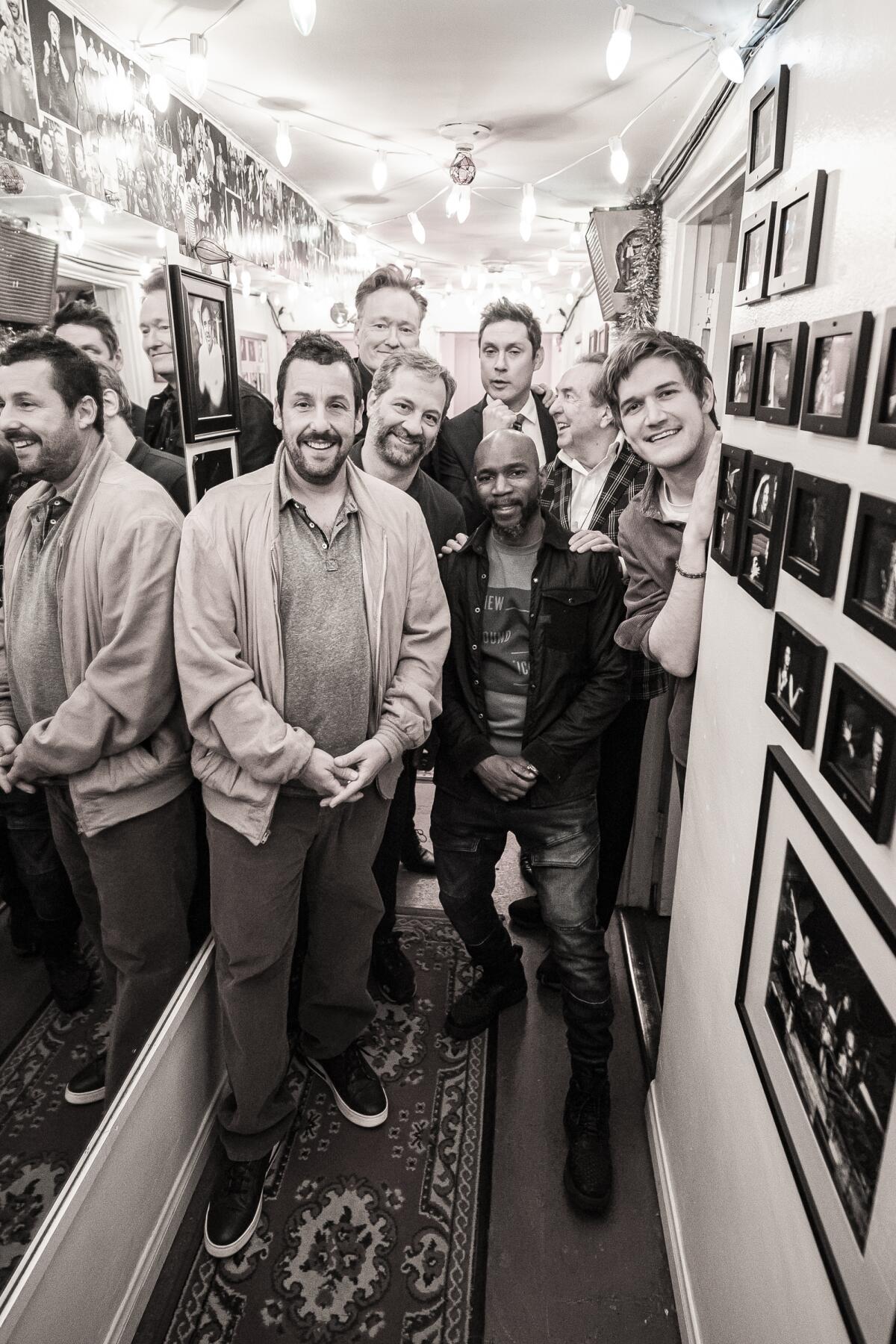
Feiner: There are comedy shows happening in every type of place on any given day, from established clubs to a friend’s garage. And the L.A. scene has everything from the most traditional stand-up to stuff that’s so out there it’s almost scarier than it is funny (I mean that as a compliment). Truly, whatever you could possibly be in the mood for, you can find it somewhere in the L.A. comedy scene.
Levy: The variety. There are so many unique venues, shows and comics that no gig is the same. One night I can be shooting a killer lineup at Ocean Mic on the beach at sunset, and then the next I’ll be shooting Ron Funches fighting pro wrestlers at the Ukrainian Cultural Center. L.A. being the film and TV hub that it is, you also get a lot of surprise drop-ins. You never know who you’ll see at a show.
Liz Viggiano (Comedy Store, Improv, Largo): It’s truly unpredictable who or what I’m going to photograph when I go into work. It’s an eclectic mix of artists. A comedian who stars in movies will perform a set followed by a comic who works the door to get stage time. Meanwhile, I’m taking photos trying not to block Quentin Tarantino’s view of the stage.
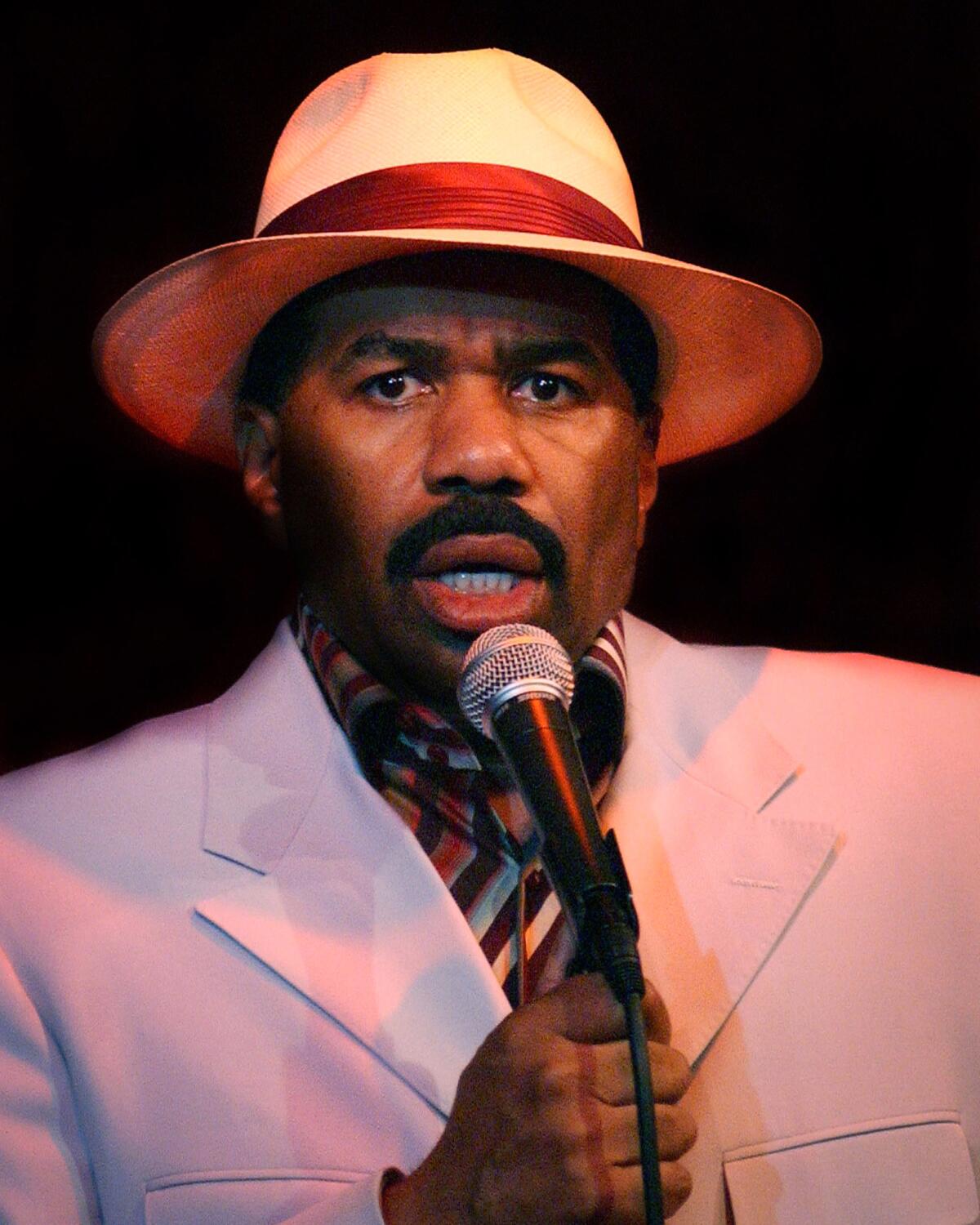
Conrad: The collaborations. Two weeks ago at the Melrose Improv, Jay Mohr and Darrell Hammond did a show together where they only did impressions the entire show and it was phenomenal. Seeing Dave Attell and Jeff Ross do “Bumping Mics” makes me cry laughing every time. Collaborations are the most unique thing about the city and very underrated. There are so many creative shows and formats, there is simply no boredom in this business.
Corona: There are so many unique voices in this city. But I truly love shooting the “post-pandemic” comedy scene in L.A. Not only did the scene never die, we are as strong as ever. The scene is filled with people that in three to five years will be household names. We are a part of the time in L.A. comedy history that was a make or break, and we made it.
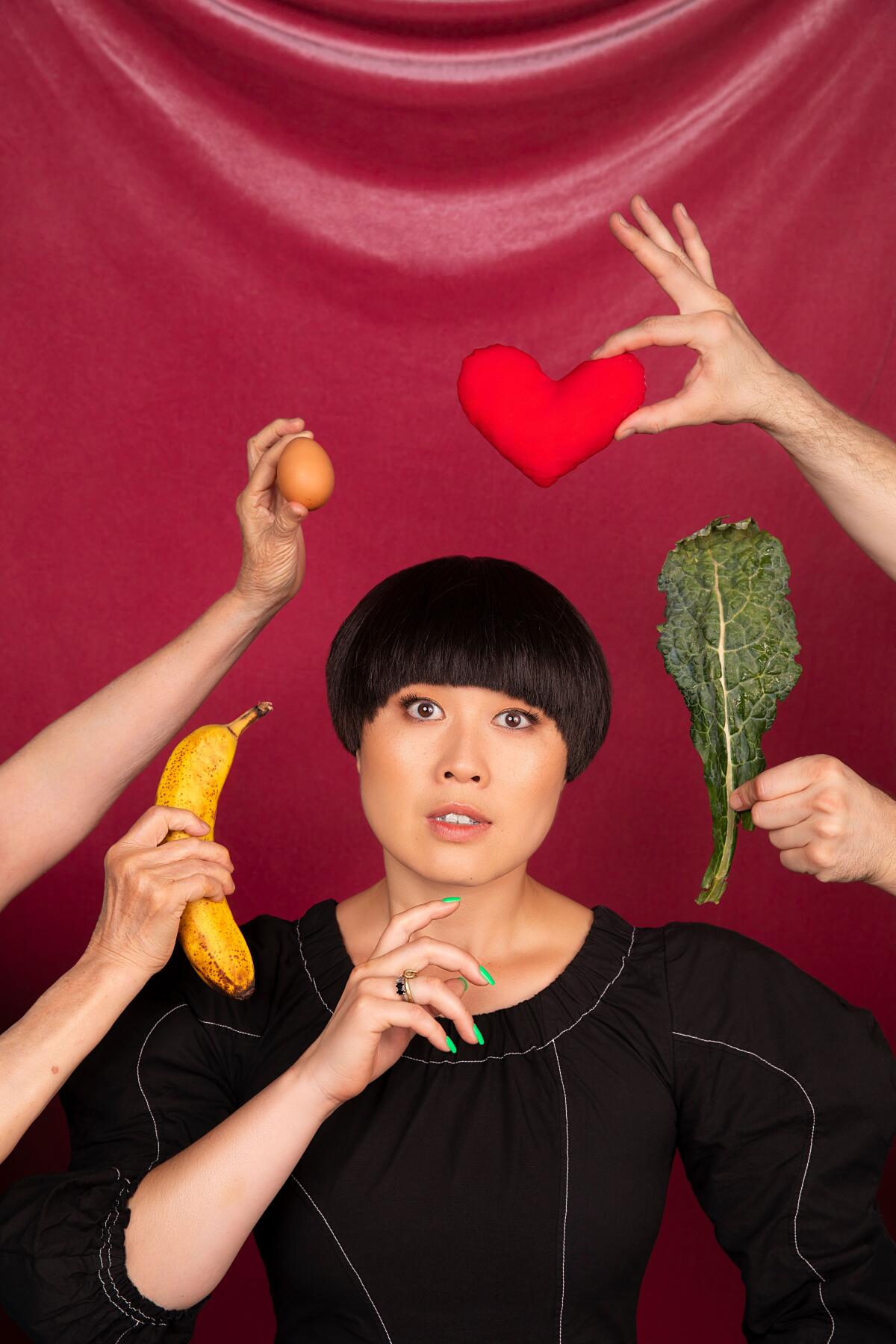
What is the most rewarding part of the gig?
Acero: Making the comedian smile or laugh with the photo I took of them is my ultimate reward.
Schwartz: When my shot is so good it knocks the socks off the person viewing it, especially if it’s a comic. I really enjoy posting my comedian photos on my Instagram page. I am proud that I have been a Getty photographer for 21 years, and I am most proud of being the official photographer for the Ice House Comedy Club going on 21 years.
Newmoney: The first people to process news, especially bad news, and talk about it in a refreshing way, are comedians. The first people I turn to get a fresh opinion on something that has just happened, especially when it’s tragic. There’s a certain skill set required in making the darkest things lighter. Or funny in the slightest. Get you a comedian who’s well-seasoned in it, and you have yourself a comedy special.
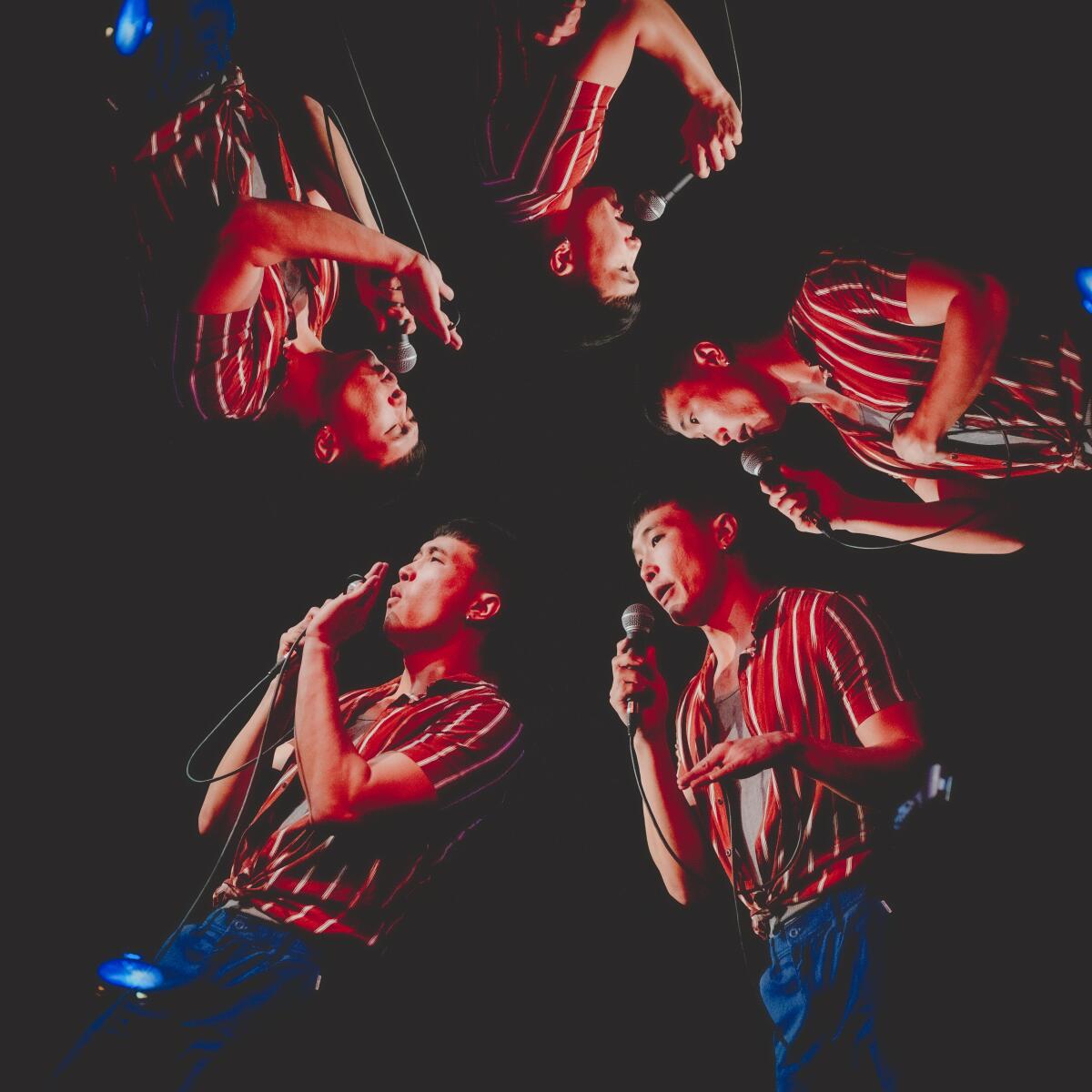
Estipona: I’ve always just considered myself a fan with a camera, so never in my wildest dreams could I have imagined the comedy scene I documented for fun would lead to meeting my comedy heroes, photos in books and album covers, making friends, and ultimately landing me a dream job as a photographer for the government. So while I mostly photograph public officials and events these days for the city of Long Beach, I do enjoy dropping into shows, and I am forever appreciative of the venues like Largo, Dynasty Typewriter and the performers who still allow me to get back to my roots and have a laugh with my camera.
Viggiano: The community, hands down. I think of the comedy clubs as family, and it’s not just the comedians. It’s the wait staff, door guys/girls, managers, etc. It feels like a home we all continuously come back to. I feel very fortunate I get to make images in such an uplifting environment.
More to Read
The biggest entertainment stories
Get our big stories about Hollywood, film, television, music, arts, culture and more right in your inbox as soon as they publish.
You may occasionally receive promotional content from the Los Angeles Times.
